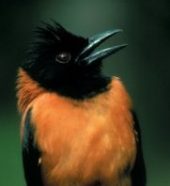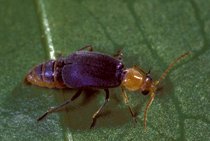Toxic Birds May Get Poison from Beetles
Eating certain beetles may make the skin and feathers of some birds poisonous.
By Emily Sohn
You’ve heard of poisonous snakes, poisonous spiders, maybe even poisonous frogs. Have you ever heard of poisonous birds?
The island of New Guinea has several types of rare birds that are, in fact, poisonous. These birds carry toxic defensive chemicals known as batrachotoxins. The same substances are also found in some of the poison frogs that live in Central America.
 |
|
The insect-eating hooded pitohui from New Guinea is about the size of a jay.
|
| John Dumbacher |
For more than a decade, scientists have been trying to figure out where the birds get their bite. The animals are not born with the poison, so they have to pick it up somehow from the environment.
Now, researchers from the California Academy of Sciences in San Francisco say they’ve found a possible source: a little-known beetle that belongs to an insect family called Choresine.
 |
|
In New Guinea, tiny Choresine beetles—each only about 7 millimeters long—carry a poison and may pass it along to insect-eating pitohui birds.
|
| John Dumbacher |
Poisonous birds were first discovered by John Dumbacher in 1989 when researchers were using fine nets to catch and release forest birds in New Guinea. Among the birds trapped for study were pitohuis, which would scratch and bite the researchers’ hands.
Dumbacher found that the cuts stung. His reaction was to put a cut to his mouth. Immediately, his mouth went tingly and numb.
In 1992, scientists figured out what the toxin was, but they still didn’t know where it came from. So, Dumbacher asked New Guinea villagers if they knew of plants or insects that cause tingling or numbing.
One resident mentioned the Choresine beetles and then went off and collected some of the tiny insects. When scientists tested the beetles, they found batrachotoxins.
Researchers have found a nonpoisonous Choresine beetle inside a pitohui’s stomach, and they know that these birds do eat other insects of this size.
It’s possible that both the beetles and the birds collect the toxin from somewhere else entirely. Most likely, though, it’s the beetle-eating that gives the birds their numbing bite.







